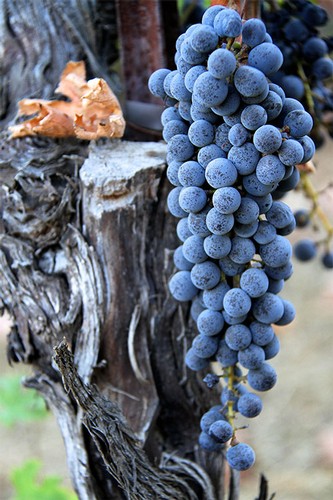Vineyards
A Vineyard provides all the essential elements to mature and ripen the grapes that are selected for the site. An ideal vineyard will develop rich ripe flavors at the same time the tannins mature and soften, thus producing a physiologically mature fruit.
Different grape varieties have different vegetative cycles, hence not all varieties can grow in the same place. This has been the quest of hope & grace wines to find the wine-grape grown in its most suitable surroundings, and experience has led us to these extraordinary vineyards.
PINOT NOIR
Doctor's Vineyard, Santa Lucia Highlands
This particular vineyard is an east facing sweeping shelf of eroded sandy loam soil, which is buffeted by cool, semi foggy winds every afternoon.
The benefits to growing great Pinot Noir in this area is that the soils are well drained, allowing the vines to focus on maturing the fruit, while the coolness of the afternoon winds extends the growing season. With the additional time on the vine, the fruit develops big bold flavors and a fuller, hardier structure than most other areas growing Pinot. Deep fruit, darker color are consistent attributes to this vineyard, and that is why we appreciate all the hard work done by the Hahn Estate to deliver us superior fruit every year.
R. Buoncristiani Vineyard, Russian River Valley, Sonoma County
On a rise in the ancient Russian River flood plain, where silty accretions formed a clay based soil sits the R. Buoncristiani Vineyard. The waters have receded to the current channel cut by the Russian River some five miles away. The river also acts a conduit for the intruding fog that is almost always present on every summer morning.
It is this cool start to the day that extends and tempers the growing conditions in this area. The grapes have time to ripen slowly, and thus add layers of spice and complexity in the mature fruit.
CABERNET SAUVIGNON
Regusci Ranch, Stag's Leap District, Napa Valley
This amazing vineyard property sits below the craggy volcanic rock formation known as the Stags Leap palisades, but, interestingly the soil is composed of an eroded Franciscan shale; sea bed. This stony bale loam soil, gently sloping down to the Silverado Trail, provides some of the finest growing conditions in the Napa Valley. After the morning fog burns back out of this little pocket (which is much sooner than the surrounding areas) surges an abundance of intense sunlight.
The fascinating effect of this pocket is how the afternoon heat creates its own convection currents that pull the cool air in from the San Pablo Bay, just to the south. The day time temperatures are cooler, allowing a longer time for the leaf to produce its photosynthesis. This results in greater development of fine fruit flavors, and a wonderfully balanced tannin structure.
Lewelling Vineyard, St. Helena, Napa Valley
There are reasons why the early settlers built towns where they did. St. Helena has an abundance of sun, but a moderating temperature shift in the evening, making the climate very livable. Grapes tend to grow best where the temperatures are most appealing to people. The Lewelling vineyard sits on a six foot, or so, bale loam soil, over a rock wash cobble, almost perfect for growing anything. But the abundant sun says Cabernet Sauvignon …Long sunny days for a variety that has one of the longest ripening requirements. The vineyard has been owned by the same family since 1860. After a time, the land becomes knowable, and what is best to do with the ground. It is this predictability and long vision that delivers almost perfectly matured grapes every year. The well drained nature of the vineyard in summer focuses the vines attention on maturing the fruit, the sunny days push the development forward and the great care taken in farming the vineyard, deliver excellent fruit every year.
MALBEC & RIESLING

Fore Family Vineyard & Losey Vineyard, Oak Knoll District
The Oak Knoll District is a remarkable growing region located on the southern end of the valley floor. With a close proximity to the San Pablo Bay the climate is cooler and more moderate than other regions in Napa Valley and provides an ideal mesoclimate for a multitude of varietals.
Our Malbec and Riesling vineyards are grown in a clay soil (Haire series), with a high water table, and during the growing season are exposed to an extraordinary amount of sunlight. The water and heavy soils delays the growth of the vine, while the sun pushes it forward - this is the push and pull of the District. With the temperate climate, the fruit has time to develop gradually, producing complex and elegant wines.
